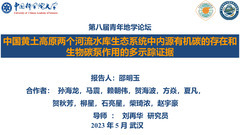报告详情
Multi-tracer evidence for the presence of autochthonous organic carbon and the role of biological carbon pump in two river–reservoir ecosystems on the Chinese Loess Plateau
编号:1484
访问权限:私有
更新:2023-04-10 19:59:40
浏览:758次
口头报告
摘要
Dissolved inorganic carbon (DIC)-rich surface waters in the karst regions of southwest China (CKR) do not necessarily emit CO2 to the atmosphere during carbonate mineral precipitation, as DIC can be partially utilized during photosynthesis by aquatic plants under the biological carbon pump (BCP) effect, leading to autochthonous organic carbon (Auto-OC). However, the operation of BCP in surface waters of the Chinese Loess Plateau (CLP), which is also enriched in DIC, has not been well established, which limits our ability to accurately assess carbon sinks in inland surface waters. We combined stable isotope (δ2H, δ18O, and δ13C), C/N, ultraviolet absorption spectroscopy, and excitation-emission matrix fluorescence approaches to investigate the sources and compositions of particulate and dissolved OC in two river–reservoir ecosystems (Wulihe (WLH)-river to WLH-reservoir and Honghe (HH)-river to HH-reservoir) on the CLP. We found that from the inflow river to reservoir areas along the course of river flow, both DOC and POC signals from autochthonous production gradually increased, especially during the wet season (WS) with the same duration of rain and heat. Compared with the HH-reservoir, the WLH-reservoir had higher δ2H, δ18O, and δ13C values, protein-like fluorescence components, chlorophyll-a (Chl-a) and DOC concentrations, and lower CO2 efflux. Our results revealed that the BCP intensity of the WLH-reservoir was higher than that of the HH-reservoir, potentially due to the long water residence time of the WLH-reservoir. Additionally, although the amount of autochthonous dissolved organic matter (Auto-DOM) produced by BCP in the surface water on the CLP was lower than that in the CKR, the proportion of Auto-DOM in the former was close to that in the latter, indicating the significance of Auto-DOM in the surface water on the CLP. Furthermore, a significant negative correlation was found between the BCP-derived Auto-DOM and pCO2, while WLH-reservoir with stronger BCP effect exhibited CO2 influx in the WS (-1.47±0.02 g m-2 d-1), indicating that the enhanced BCP process contributed to the water–air interface C sink. Our research emphasizes the high BCP potential of surface water in the CLP, and provides a valuable elementary background to better understanding of the carbon cycle in the aquatic ecosystem of the CLP.
关键词
Biological carbon pump; River–reservoir ecosystems; Autochthonous organic carbon; Chinese Loess Plateau; Stable isotope; EEM-PARAFRAC
报告人

邵明玉
中国科学院地球化学研究所稿件作者
全部评论
重要日期
-
会议日期
05月05日
2023
至05月08日
2023
-
03月31日 2023
初稿截稿日期
-
05月25日 2023
注册截止日期
主办单位
青年地学论坛理事会
中国科学院青年创新促进会地学分会
中国科学院青年创新促进会地学分会
承办单位
武汉大学
中国科学院精密测量科学与技术创新研究院
中国地质大学(武汉)
中国科学院精密测量科学与技术创新研究院
中国地质大学(武汉)



发表评论